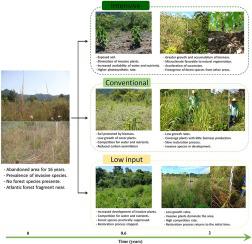当前位置:
X-MOL 学术
›
Forest Ecol. Manag.
›
论文详情
Our official English website, www.x-mol.net, welcomes your
feedback! (Note: you will need to create a separate account there.)
Intensive silvicultural practices drive the forest restoration in southern Brazil
Forest Ecology and Management ( IF 3.7 ) Pub Date : 2020-10-01 , DOI: 10.1016/j.foreco.2020.118325 Felipe Turchetto , Maristela Machado Araujo , Luciane Almeri Tabaldi , Adriana Maria Griebeler , Daniele Guarienti Rorato , Álvaro Luís Pasquetti Berghetti , Felipe Manzoni Barbosa , Marllos Santos de Lima , Claudia Costella , Victória Martini Sasso
Forest Ecology and Management ( IF 3.7 ) Pub Date : 2020-10-01 , DOI: 10.1016/j.foreco.2020.118325 Felipe Turchetto , Maristela Machado Araujo , Luciane Almeri Tabaldi , Adriana Maria Griebeler , Daniele Guarienti Rorato , Álvaro Luís Pasquetti Berghetti , Felipe Manzoni Barbosa , Marllos Santos de Lima , Claudia Costella , Victória Martini Sasso

|
Abstract The restoration of degraded environments is a challenging process due to the presence of adverse factors, which can prevent the establishment and development of forest species. The use of appropriate methods and species, which are able to adapt to the soil and climatic conditions, enable successful conservation plantings. Herein, we aim to identify the performance of native forest species grown under two planting models and different silvicultural practices in a degraded riparian area in the extreme south of the Atlantic Forest Biome. The experiment was initiated in September 2015 with a randomized block design arranged in a 3 × 2 factorial scheme (three silvicultural practices and two planting models). We evaluated the performance of nine native species by the analysis of morphological (i.e., survival, height, and stem diameter) and physiological attributes (i.e., photosynthetic pigments and chlorophyll a fluorescence). The use of intensive silvicultural practices in restoration plantations maximized tree survival rates, height, and stem growth, and provided better values for the physiological attributes. The two planting models tested in this study (i.e., “framework species” and diversity) can be used in future restoration projects in subtropical regions associated with intensive silvicultural practices. Solanum mauritianum, among other studied species, presented excellent rates of survival and growth. Several secondary species (e.g., Actinostemon concolor, Trichilia elegans, and Eugenia rostrifolia) propagated from the seedling transplants, also showed the potential to enrich forest plantations in degraded environments.
中文翻译:

密集的造林实践推动了巴西南部的森林恢复
摘要 退化环境的恢复是一个具有挑战性的过程,因为不利因素的存在会阻碍森林物种的建立和发展。使用能够适应土壤和气候条件的适当方法和物种,能够成功地进行保护性种植。在此,我们旨在确定在大西洋森林生物群落最南端退化的河岸地区在两种种植模式和不同造林做法下生长的本地森林物种的表现。该试验于 2015 年 9 月启动,采用随机区组设计,按 3 × 2 因子方案(三种造林做法和两种种植模式)进行安排。我们通过形态学分析(即存活率、高度、和茎直径)和生理属性(即光合色素和叶绿素 a 荧光)。在恢复人工林中使用集约化造林实践可最大限度地提高树木的成活率、高度和茎的生长,并为生理属性提供更好的价值。本研究中测试的两种种植模式(即“框架物种”和多样性)可用于与集约化造林实践相关的亚热带地区未来的恢复项目。Solanum mauritianum,在其他研究物种中,呈现出极好的存活率和生长率。从幼苗移植繁殖的几种次生物种(例如,Actinostemon concolor、Trichilia elegans 和 Eugenia rostrifolia)也显示出在退化环境中丰富森林种植园的潜力。光合色素和叶绿素 a 荧光)。在恢复人工林中使用集约化造林实践使树木成活率、高度和茎生长最大化,并为生理属性提供了更好的价值。本研究中测试的两种种植模式(即“框架物种”和多样性)可用于与集约化造林实践相关的亚热带地区未来的恢复项目。Solanum mauritianum,在其他研究物种中,呈现出极好的存活率和生长率。从幼苗移植繁殖的几种次生物种(例如,Actinostemon concolor、Trichilia elegans 和 Eugenia rostrifolia)也显示出在退化环境中丰富森林种植园的潜力。光合色素和叶绿素 a 荧光)。在恢复人工林中使用集约化造林实践可最大限度地提高树木的成活率、高度和茎的生长,并为生理属性提供更好的价值。本研究中测试的两种种植模式(即“框架物种”和多样性)可用于与集约化造林实践相关的亚热带地区未来的恢复项目。Solanum mauritianum,在其他研究物种中,呈现出极好的存活率和生长率。从幼苗移植繁殖的几种次生物种(例如,Actinostemon concolor、Trichilia elegans 和 Eugenia rostrifolia)也显示出在退化环境中丰富森林种植园的潜力。在恢复人工林中使用集约化造林实践可最大限度地提高树木的成活率、高度和茎的生长,并为生理属性提供更好的价值。本研究中测试的两种种植模式(即“框架物种”和多样性)可用于与集约化造林实践相关的亚热带地区未来的恢复项目。Solanum mauritianum,在其他研究物种中,呈现出极好的存活率和生长率。从幼苗移植繁殖的几种次生物种(例如,Actinostemon concolor、Trichilia elegans 和 Eugenia rostrifolia)也显示出在退化环境中丰富森林种植园的潜力。在恢复人工林中使用集约化造林实践可最大限度地提高树木的成活率、高度和茎的生长,并为生理属性提供更好的价值。本研究中测试的两种种植模式(即“框架物种”和多样性)可用于与集约化造林实践相关的亚热带地区未来的恢复项目。Solanum mauritianum,在其他研究物种中,呈现出极好的存活率和生长率。从幼苗移植繁殖的几种次生物种(例如,Actinostemon concolor、Trichilia elegans 和 Eugenia rostrifolia)也显示出在退化环境中丰富森林种植园的潜力。并为生理属性提供更好的值。本研究中测试的两种种植模式(即“框架物种”和多样性)可用于与集约化造林实践相关的亚热带地区未来的恢复项目。Solanum mauritianum 和其他研究的物种一样,呈现出极好的存活率和生长率。从幼苗移植繁殖的几种次生物种(例如,Actinostemon concolor、Trichilia elegans 和 Eugenia rostrifolia)也显示出在退化环境中丰富森林种植园的潜力。并为生理属性提供更好的值。本研究中测试的两种种植模式(即“框架物种”和多样性)可用于与集约化造林实践相关的亚热带地区未来的恢复项目。Solanum mauritianum,在其他研究物种中,呈现出极好的存活率和生长率。从幼苗移植繁殖的几种次生物种(例如,Actinostemon concolor、Trichilia elegans 和 Eugenia rostrifolia)也显示出在退化环境中丰富森林种植园的潜力。呈现出极好的存活率和生长率。从幼苗移植繁殖的几种次生物种(例如,Actinostemon concolor、Trichilia elegans 和 Eugenia rostrifolia)也显示出在退化环境中丰富森林种植园的潜力。呈现出极好的存活率和生长率。从幼苗移植繁殖的几种次生物种(例如,Actinostemon concolor、Trichilia elegans 和 Eugenia rostrifolia)也显示出在退化环境中丰富森林种植园的潜力。
更新日期:2020-10-01
中文翻译:

密集的造林实践推动了巴西南部的森林恢复
摘要 退化环境的恢复是一个具有挑战性的过程,因为不利因素的存在会阻碍森林物种的建立和发展。使用能够适应土壤和气候条件的适当方法和物种,能够成功地进行保护性种植。在此,我们旨在确定在大西洋森林生物群落最南端退化的河岸地区在两种种植模式和不同造林做法下生长的本地森林物种的表现。该试验于 2015 年 9 月启动,采用随机区组设计,按 3 × 2 因子方案(三种造林做法和两种种植模式)进行安排。我们通过形态学分析(即存活率、高度、和茎直径)和生理属性(即光合色素和叶绿素 a 荧光)。在恢复人工林中使用集约化造林实践可最大限度地提高树木的成活率、高度和茎的生长,并为生理属性提供更好的价值。本研究中测试的两种种植模式(即“框架物种”和多样性)可用于与集约化造林实践相关的亚热带地区未来的恢复项目。Solanum mauritianum,在其他研究物种中,呈现出极好的存活率和生长率。从幼苗移植繁殖的几种次生物种(例如,Actinostemon concolor、Trichilia elegans 和 Eugenia rostrifolia)也显示出在退化环境中丰富森林种植园的潜力。光合色素和叶绿素 a 荧光)。在恢复人工林中使用集约化造林实践使树木成活率、高度和茎生长最大化,并为生理属性提供了更好的价值。本研究中测试的两种种植模式(即“框架物种”和多样性)可用于与集约化造林实践相关的亚热带地区未来的恢复项目。Solanum mauritianum,在其他研究物种中,呈现出极好的存活率和生长率。从幼苗移植繁殖的几种次生物种(例如,Actinostemon concolor、Trichilia elegans 和 Eugenia rostrifolia)也显示出在退化环境中丰富森林种植园的潜力。光合色素和叶绿素 a 荧光)。在恢复人工林中使用集约化造林实践可最大限度地提高树木的成活率、高度和茎的生长,并为生理属性提供更好的价值。本研究中测试的两种种植模式(即“框架物种”和多样性)可用于与集约化造林实践相关的亚热带地区未来的恢复项目。Solanum mauritianum,在其他研究物种中,呈现出极好的存活率和生长率。从幼苗移植繁殖的几种次生物种(例如,Actinostemon concolor、Trichilia elegans 和 Eugenia rostrifolia)也显示出在退化环境中丰富森林种植园的潜力。在恢复人工林中使用集约化造林实践可最大限度地提高树木的成活率、高度和茎的生长,并为生理属性提供更好的价值。本研究中测试的两种种植模式(即“框架物种”和多样性)可用于与集约化造林实践相关的亚热带地区未来的恢复项目。Solanum mauritianum,在其他研究物种中,呈现出极好的存活率和生长率。从幼苗移植繁殖的几种次生物种(例如,Actinostemon concolor、Trichilia elegans 和 Eugenia rostrifolia)也显示出在退化环境中丰富森林种植园的潜力。在恢复人工林中使用集约化造林实践可最大限度地提高树木的成活率、高度和茎的生长,并为生理属性提供更好的价值。本研究中测试的两种种植模式(即“框架物种”和多样性)可用于与集约化造林实践相关的亚热带地区未来的恢复项目。Solanum mauritianum,在其他研究物种中,呈现出极好的存活率和生长率。从幼苗移植繁殖的几种次生物种(例如,Actinostemon concolor、Trichilia elegans 和 Eugenia rostrifolia)也显示出在退化环境中丰富森林种植园的潜力。并为生理属性提供更好的值。本研究中测试的两种种植模式(即“框架物种”和多样性)可用于与集约化造林实践相关的亚热带地区未来的恢复项目。Solanum mauritianum 和其他研究的物种一样,呈现出极好的存活率和生长率。从幼苗移植繁殖的几种次生物种(例如,Actinostemon concolor、Trichilia elegans 和 Eugenia rostrifolia)也显示出在退化环境中丰富森林种植园的潜力。并为生理属性提供更好的值。本研究中测试的两种种植模式(即“框架物种”和多样性)可用于与集约化造林实践相关的亚热带地区未来的恢复项目。Solanum mauritianum,在其他研究物种中,呈现出极好的存活率和生长率。从幼苗移植繁殖的几种次生物种(例如,Actinostemon concolor、Trichilia elegans 和 Eugenia rostrifolia)也显示出在退化环境中丰富森林种植园的潜力。呈现出极好的存活率和生长率。从幼苗移植繁殖的几种次生物种(例如,Actinostemon concolor、Trichilia elegans 和 Eugenia rostrifolia)也显示出在退化环境中丰富森林种植园的潜力。呈现出极好的存活率和生长率。从幼苗移植繁殖的几种次生物种(例如,Actinostemon concolor、Trichilia elegans 和 Eugenia rostrifolia)也显示出在退化环境中丰富森林种植园的潜力。











































 京公网安备 11010802027423号
京公网安备 11010802027423号